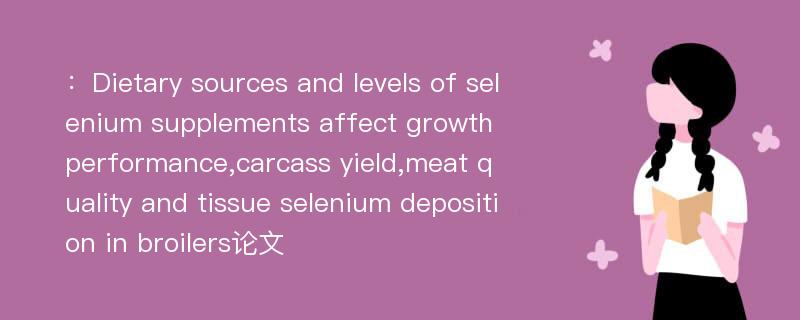
本文主要研究内容
作者(2019)在《Dietary sources and levels of selenium supplements affect growth performance,carcass yield,meat quality and tissue selenium deposition in broilers》一文中研究指出:This study examined the effects of sources and levels of selenium(Se)on performance,carcass parts yield,meat quality and tissue Se concentration in broilers.A total of 960 one-day-old male broilers were divided into 8 treatments in a 4 x 2 factorial arrangement.Chicks were penned in groups of 20 with6 pens per group.Selenium sources were sodium selenite(SS),Se enriched yeast(SY),DLselenomethionine(SM)and nano-selenium(NS)and dietary supplemental Se levels were 0.1 and0.3 mg/kg diet.The average daily gain(ADG),average daily feed intake(ADFI),feed:gain ratio,mortality,and carcass parts yield were not affected by dietary treatments.The level of 0.3 mg/kg Se decreased lightness and increased yellowness of the breast and thighs(P<0.001).Nano-selenium improved yellowness,redness and meat quality(P<0.05).The interactive effects of sources and the levels of Se affected Se retention(P<0.001).Inorganic Se showed poor retention compared to other sources of Se;and NS showed equal retention with the organic sources.With consideration to meat quality responses,NS had a more signific:ant positive effect compared to SS as an inorganic source of Se.Overall,NS and organic sources of Se resulted in better meat quality compared with the inorganic source.Moreover,the highest Se retention percentage was achieved by supplementation of NS followed by organic sources at0.1 mg/kg compared to SS.
Abstract
This study examined the effects of sources and levels of selenium(Se)on performance,carcass parts yield,meat quality and tissue Se concentration in broilers.A total of 960 one-day-old male broilers were divided into 8 treatments in a 4 x 2 factorial arrangement.Chicks were penned in groups of 20 with6 pens per group.Selenium sources were sodium selenite(SS),Se enriched yeast(SY),DLselenomethionine(SM)and nano-selenium(NS)and dietary supplemental Se levels were 0.1 and0.3 mg/kg diet.The average daily gain(ADG),average daily feed intake(ADFI),feed:gain ratio,mortality,and carcass parts yield were not affected by dietary treatments.The level of 0.3 mg/kg Se decreased lightness and increased yellowness of the breast and thighs(P<0.001).Nano-selenium improved yellowness,redness and meat quality(P<0.05).The interactive effects of sources and the levels of Se affected Se retention(P<0.001).Inorganic Se showed poor retention compared to other sources of Se;and NS showed equal retention with the organic sources.With consideration to meat quality responses,NS had a more signific:ant positive effect compared to SS as an inorganic source of Se.Overall,NS and organic sources of Se resulted in better meat quality compared with the inorganic source.Moreover,the highest Se retention percentage was achieved by supplementation of NS followed by organic sources at0.1 mg/kg compared to SS.
论文参考文献
论文详细介绍
论文作者分别是来自Animal Nutrition的,发表于刊物Animal Nutrition2019年03期论文,是一篇关于,Animal Nutrition2019年03期论文的文章。本文可供学术参考使用,各位学者可以免费参考阅读下载,文章观点不代表本站观点,资料来自Animal Nutrition2019年03期论文网站,若本站收录的文献无意侵犯了您的著作版权,请联系我们删除。
